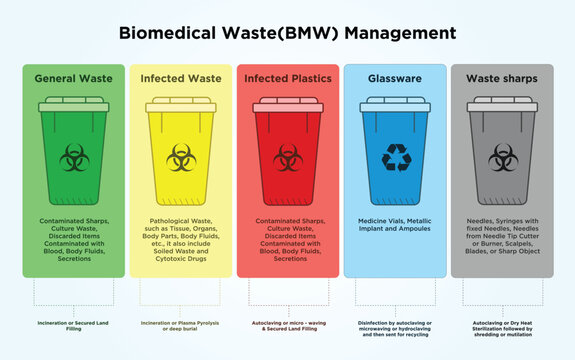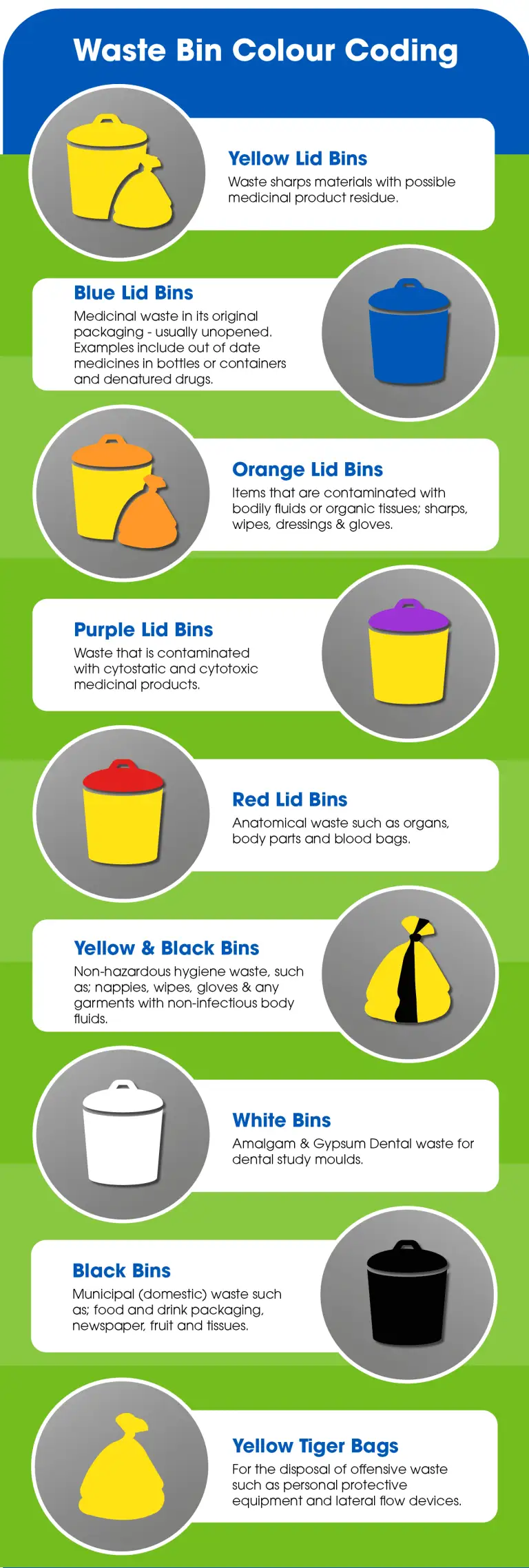Compliance and Regulations for Medical Garbage Disposal
Compliance and policies for clinical garbage disposal play a crucial duty in guaranteeing the safety and security and well-being of both medical care specialists and the public. Correct monitoring of medical waste is vital to protect against the spread of infections, safeguard the setting, and keep public wellness. This needs adherence to specific standards and procedures stated by governing agencies and bodies. These laws incorporate numerous aspects, including the classification and segregation of clinical waste, appropriate storage space and dealing with procedures, along with transportation and disposal methods. By complying with these laws, medical care centers can minimize the danger of contamination and possible injury to individuals and the environment. This short article will check out the importance of conformity and provide a summary of the essential laws controling clinical waste disposal.
Importance of Conformity
The value of compliance with policies for medical garbage disposal can not be overstated. Proper disposal of medical waste is important for guaranteeing the security and wellness of medical care workers, patients, and the public. Medical waste, that includes things such as utilized needles, polluted gloves, and biomedical waste, can present severe health risks if not handled and taken care of appropriately.
Compliance with regulations guarantees that clinical waste is taken care of in a method that decreases the possibility for exposure to transmittable illness and dangerous materials - medical waste disposal service. It aids prevent the spread of infections, such as HIV, hepatitis B and C, and various other bloodborne virus. Compliance additionally plays an essential function in protecting the environment by protecting against contamination of water resources, soil, and air
Failure to abide by guidelines can result in extreme effects for medical care centers, including fines, lawful action, and damage to their credibility. In addition, non-compliance might endanger the health and safety and security of healthcare workers, patients, and the area.
Conformity with laws for medical waste disposal needs adherence to certain guidelines and methods. These might consist of proper partition, product packaging, labeling, and storage of clinical waste. It additionally entails making use of accepted disposal methods, such as autoclaving, incineration, or landfilling, relying on the kind of waste.
Governing Agencies and Bodies
Regulative companies and bodies play an important function in looking after conformity with guidelines for clinical waste disposal. These companies are in charge of establishing guidelines, standards, and procedures to make certain the secure and proper handling of medical waste. They enforce and keep track of conformity to protect public wellness and the atmosphere.
One of one of the most popular governing agencies in the USA is the Epa (EPA) The EPA is accountable for regulating the storage, transportation, therapy, and disposal of clinical waste. They establish guidelines for waste generators, carriers, and treatment facilities to follow, guaranteeing that all essential safety measures are required to stop the spread of illness and contamination.
One more crucial regulatory body is the Occupational Safety and Health And Wellness Administration (OSHA) OSHA sets laws and requirements to shield workers from work dangers, consisting of those pertaining to medical waste. WasteX Medical Waste Disposal. They provide standards for the risk-free handling and disposal of medical waste to shield employees in medical care centers
In enhancement to these government firms, specific states additionally have their very own regulatory bodies that manage clinical waste disposal. These firms might have their very own details policies and needs that should be adhered to.

Classification and Segregation of Medical Waste
To make sure appropriate management of medical waste, it is vital to identify and segregate it according to established guidelines and procedures. medical waste removal. Category and segregation play an important function in decreasing the danger of infection, securing the environment, and making sure the safety of health care employees and the public
Clinical waste is identified right into various groups based on its prospective hazard degree. These groups include contagious waste, pathological waste, sharps waste, pharmaceutical waste, chemical waste, and radioactive waste. Each classification calls for particular handling, transportation, disposal, and storage space techniques to minimize the danger of direct exposure and contamination.
Partition of clinical waste includes separating various sorts of waste at the source. This procedure ensures that waste with various risk degrees is not mixed, decreasing the potential for cross-contamination and making disposal treatments extra reliable. Correct partition is achieved with using color-coded labels and containers, which assist health care workers and waste management workers take care of each kind and identify of waste appropriately.
In addition to category and segregation, healthcare centers have to likewise stick to local, state, and federal regulations pertaining to clinical waste management. These guidelines outline certain requirements for storage, transport, treatment, and final disposal of medical waste, making sure compliance and maintaining public health and security.
Correct Storage and Taking Care Of Treatments
Proper storage and handling procedures play an essential function in guaranteeing the compliant and safe management of clinical waste. Medical waste, which includes products such as used syringes, polluted handwear covers, and ran out medicines, can posture serious health and environmental risks if not handled properly. It is vital for medical care centers and other generators of clinical waste to apply strict storage and dealing with methods.
To begin with, clinical waste ought to be stored in sturdy, leak-proof containers that are particularly designed for this function. These containers ought to be labeled with check it out the global biohazard symbol and words "clinical waste" to clearly show the materials. Furthermore, the containers should be maintained safely near to stop any prospective leakage or splilling.
In addition, it is necessary to segregate different types of medical waste to stop cross-contamination. Sharps, such as scalpels and needles, need to be kept in puncture-resistant containers to minimize the threat of injuries - WasteX Medical Waste Disposal. Chemical waste, such as anti-bacterials and solvents, need to be kept independently from various other kinds of clinical waste to avoid harmful direct exposures or chemical reactions

Transportation and Disposal Methods
Health care facilities have to make sure the secure transport and appropriate disposal of their clinical waste to abide by guidelines and shield public health and wellness. Transport and disposal methods play a crucial role in protecting against the spread of infectious diseases and decreasing the environmental effect of clinical waste.
To deliver medical waste, healthcare facilities need to use puncture-resistant and watertight containers that are classified with the biohazard symbol. These containers must be securely sealed to stop any type of leak throughout transportation. Additionally, medical care facilities must establish methods for the transport procedure, consisting of making use of experienced employees and dedicated cars.
As soon as the clinical waste reaches the disposal center, it undergoes various methods of therapy. One typical technique is incineration, which entails shedding the waste at heats to damage virus and reduce the quantity of waste. Another technique is autoclaving, which utilizes heavy steam and pressure to decontaminate the waste. After therapy, the waste is typically sent to a land fill or a waste-to-energy facility for final disposal.
It is crucial for healthcare centers to collaborate with accredited and allowed waste management firms to ensure proper transportation and disposal of clinical waste. These companies have the proficiency and sources to deal with medical waste securely and in conformity with regulations.
Final Thought
To conclude, conformity with guidelines for medical garbage disposal is of utmost significance to make sure public health and security. Regulative companies and bodies play a critical duty in implementing these policies. Appropriate classification and partition of clinical waste, along with complying with appropriate storage and managing procedures, are necessary to stop contamination and the spread of illness. Adequate transport and disposal techniques need to be implemented to minimize ecological impacts. In general, adherence to compliance and laws is essential to properly take care of medical waste.
Clinical waste, which consists of things such as utilized needles, polluted handwear covers, and biomedical waste, can pose severe wellness risks if not handled and disposed of correctly.
These classifications include transmittable waste, pathological waste, sharps waste, pharmaceutical waste, chemical waste, and radioactive waste.Segregation of medical waste involves dividing different types of waste at the resource. Correct partition is accomplished through the use of color-coded containers and labels, which aid health care workers and waste management employees identify and manage each kind of waste properly.
Chemical waste, such as solvents and anti-bacterials, need to be stored individually from other types of medical waste to avoid hazardous exposures or chemical responses.